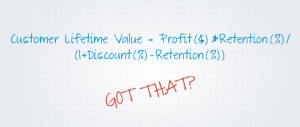Customer Lifetime Value: The Metric Marketers Often Forget, But Shouldn’t

Marketing and sales strive to quickly push buyers from a first interaction to an initial purchase in order to drive short-term revenue. However, it shouldn’t stop there. If marketers gain a greater understanding of what their consumers want, they can effectively develop strategies to continually interact with those consumers once an acquisition has been made, thus leading to a steady stream of ROI.
Unfortunately, this hasn’t been the case for all marketers. Often times, sales and marketing are rewarded for immediate acquisitions and keeping the momentum going with a steady stream of new acquisitions. But should we really just focus on new customer acquisition, or are we also forgetting about the value of customer retention and what that can mean for ROI year over year?
Customer Lifetime Value: What is It?
Think of Customer Lifetime Value (CLV) as the ROI a single customer will produce over the lifespan of their interaction with your product or service. As a forward-looking metric, CLV helps marketing experts calculate and predict future revenues from present day customer acquisitions. In 2014 alone, $137.5 billion was spent in digital advertising, but do we know where it all went? Using CLV to make informed metric-driven decisions, marketers can better allocate marketing budget to focus on building engagement campaigns that reach these customers on the right channel at the right time with the right message, thus ensuring repeat acquisitions as opposed to one-time acquisitions.
How Do You Calculate CLV?
Marketers can calculate their CLV using this simple formula below:

Over the course of a customer’s interaction with your brand there is also the potential for upsells. For example, consider the car buying process. You are a car sales rep and have just sold a brand new car. Of course you could sign the papers and walk away pleased with your new customer acquisition, but as the sales rep, have you considered the upsells available? Why not add in an additional service package or regular car washes? These simple upsells ensure your customer will continue to interact with your brand over the course of the next couple of years, or possibly a lifetime, and could also help predict future recurring revenues for your business.
How Do You Elevate CLV as a Golden Metric?
Remember Customer Satisfaction is Paramount: A happy customer typically equals a repeat customer. If a product or service can tailor their customer service to meet the needs of their customers, it is almost guaranteed that the consumer will continue to make repeat acquisitions. At the end of the day, we are all human. Companies need to engage with the end user in a personalized approach that makes them feel valued and appreciated.
Zero in on “Good” Customers: Don’t be afraid to financially invest more in a good customer from the start. Sales can acquire new customers left and right, but have you ever calculated the cost of losing a customer? You may want to rethink your strategy and instead focus your efforts on acquiring good customers who will respond with brand loyalty as opposed to “quick” low-hanging-fruit customers that have higher turnover.
Invest in a Dedicated Upsells Team: Once you acquire your good customers, it is imperative that an organization has a dedicated customer success or upsells team. This group should focus on unlocking new revenue opportunities and unearthing customers’ true CLV by providing dedicated support teams that act as an extension of customers’ internal teams.
Develop Engaging Marketing Campaigns: Marketing needs to be accountable by relying on metrics from their marketing campaigns to create engaging content that propels customers along the customer journey. Marketing teams can rely on CLV to make informed decisions about when to increase their marketing investments, pull back their spend and target engaging campaigns to consumers on the right channel.
Looking to Learn More?
If you are interested in learning more about why CLV has been elevated to the status of the golden metric in 2015, download the free webinar featuring thought leaders from Marketo and CAKE.